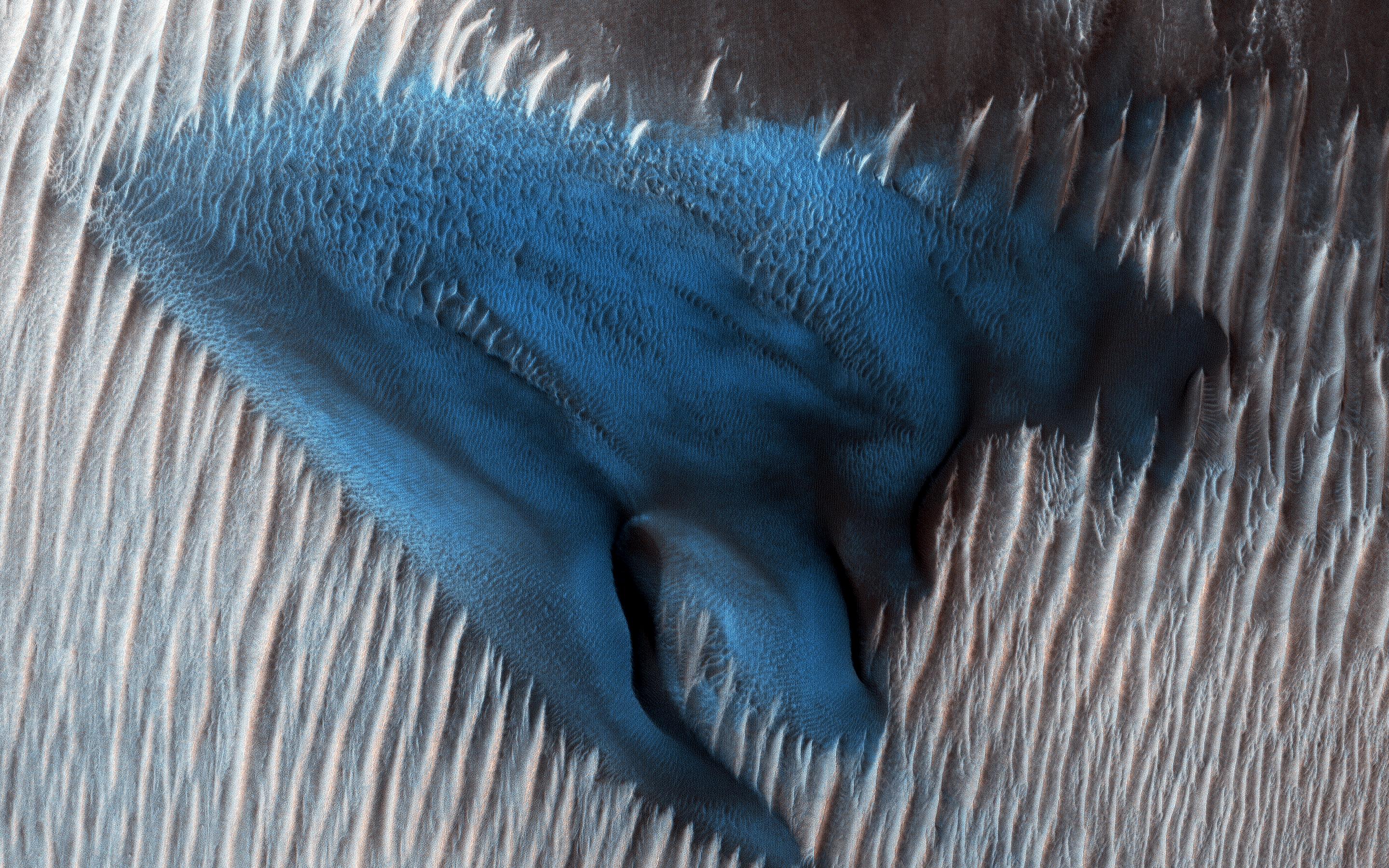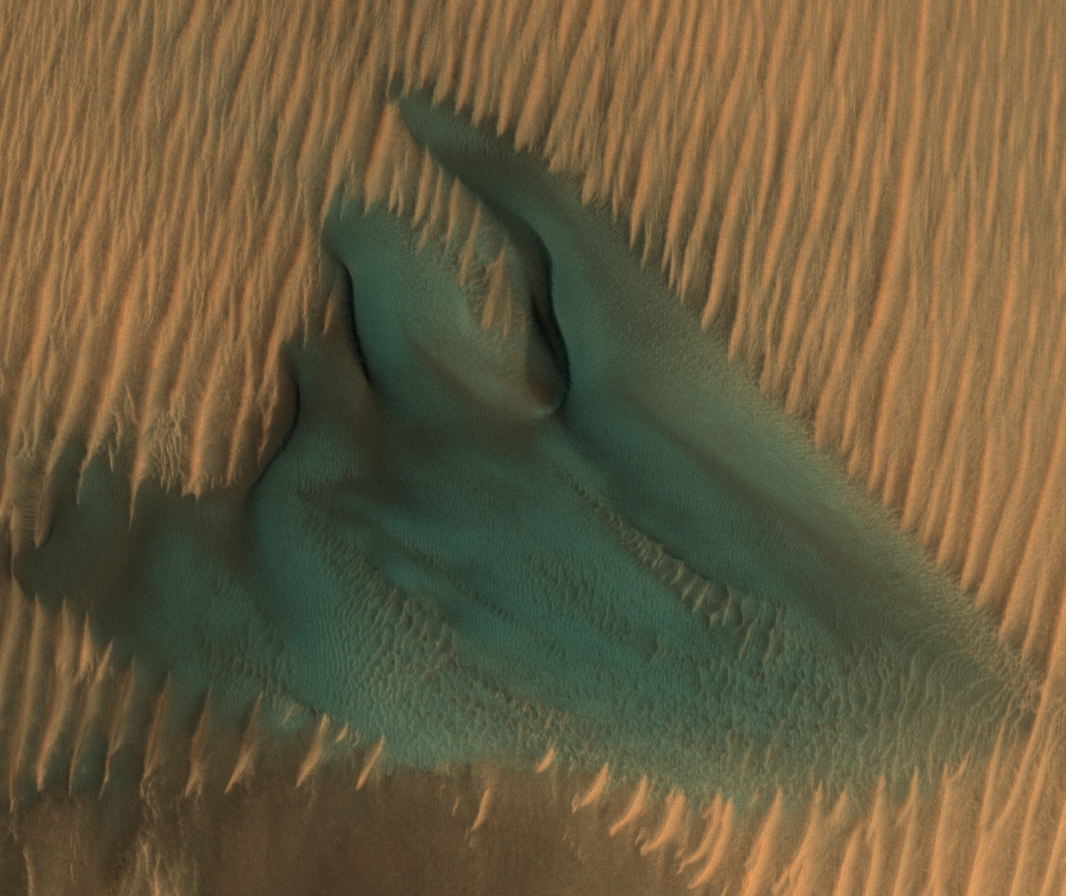It looks like you're using an Ad Blocker.
Please white-list or disable AboveTopSecret.com in your ad-blocking tool.
Thank you.
Some features of ATS will be disabled while you continue to use an ad-blocker.
share:
There's no conspiracy here, ATS, just a really cool image from Mars. This is a blue dune in the Lyot Crater region of Mars which has a very
interesting shape and look to it.

I can see different images in the picture. What do you see?
A blue dune.....? The mere thought of something like this being possible on Mars intrigues me. Life never ceases to amaze. What says ATS?
www.nasa.gov...

I can see different images in the picture. What do you see?
Sand dunes often accumulate in the floors of craters. In this region of Lyot Crater, NASA's Mars Reconnaissance Orbiter (MRO) shows a field of classic barchan dunes on Jan. 24, 2018. Just to the south of the group of barchan dunes is one large dune with a more complex structure. This particular dune, appearing like turquoise blue in enhanced color, is made of finer material and/or has a different composition than the surrounding. The map is projected above at a scale of 25 centimeters (9.8 inches) per pixel. [The original image scale is 34.7 centimeters (13.7 inches) per pixel (with 1 x 1 binning); objects on the order of 104 centimeters (40.9 inches) across are resolved.] North is up.
A blue dune.....? The mere thought of something like this being possible on Mars intrigues me. Life never ceases to amaze. What says ATS?
www.nasa.gov...
Looks like a mineral called phyllosilicates. Which reading around, suggests more recent water than thought.
Cool. Thanks for sharing, I want to buy a telescope now.
Cool. Thanks for sharing, I want to buy a telescope now.
Your right, I can see lots of images too. I can see a blue bison kneeling down on its front legs eat the long grass as well as other things
a reply to: moebius
Its important not to forget details like that.
When we build our mental picture of Mars, we cannot help but see these things in the colours we are shown, but if we really think about it, if we learn a little science, we can imagine more accurately than the pictures we see can show us, what shades and contrasts we are dealing with.
I still think that it should not be as hard as it seems to be, to just take a damned photograph that shows precisely what a human eye would.
Its important not to forget details like that.
When we build our mental picture of Mars, we cannot help but see these things in the colours we are shown, but if we really think about it, if we learn a little science, we can imagine more accurately than the pictures we see can show us, what shades and contrasts we are dealing with.
I still think that it should not be as hard as it seems to be, to just take a damned photograph that shows precisely what a human eye would.
a reply to: lostbook
As you can see here from your article....
As you can see here from your article....
This particular dune, appearing like turquoise blue in enhanced color, is made of finer material and/or has a different composition than the surrounding.
They just made it look blue by enhancing the colors so that it could be seen easier. Cool pic though!
Who would have thunk ?
Aliens on Mars...
Come from light years away to mine the Blue "Spice"
Aliens on Mars...
Come from light years away to mine the Blue "Spice"
a reply to: lostbook
The reason for the false color/enhanced color is so the researches can better see certain soils, materials, or features.
Different materials reflect different wavelengths of light, but they still may look like similar colors, making it hard to distinguish the extents of different features. So the imaging team will often artificially assign the color "blue" to the reflect light wavelength of the materials they want to study, because blue contrasts well against the yellow, brown, or ruddy hues of the surrounding soil, making the feature that they wish to study stand out against the background.
The reason for the false color/enhanced color is so the researches can better see certain soils, materials, or features.
Different materials reflect different wavelengths of light, but they still may look like similar colors, making it hard to distinguish the extents of different features. So the imaging team will often artificially assign the color "blue" to the reflect light wavelength of the materials they want to study, because blue contrasts well against the yellow, brown, or ruddy hues of the surrounding soil, making the feature that they wish to study stand out against the background.
a reply to: Alien Abduct
too many 'artistic freedoms' with images communicated with the public from NASA
too many 'artistic freedoms' with images communicated with the public from NASA
originally posted by: odzeandennz
a reply to: Alien Abduct
too many 'artistic freedoms' with images communicated with the public from NASA
As I said above, there are valid reasons to use false color imagery in the course of normal research, and they virtaully always indicate when an image is false color or color enhanced. It's not for artistic reason or to fool people.
I for one like to see these color-enhanced images researchers use as a part of that research. I think this dune in true color would not easily show me the intersting details, such as the edge extents.
edit on 25/6/2018 by Soylent Green Is People because: (no reason given)
The official HiRISE site provides approximately true-colour versions of the images too. www.uahirise.org...
Here's an (approximately) true-colour image of that dune: hirise-pds.lpl.arizona.edu...

It still looks kinda blue, which may point to basaltic material.
Here's an (approximately) true-colour image of that dune: hirise-pds.lpl.arizona.edu...

It still looks kinda blue, which may point to basaltic material.
originally posted by: wildespace
The official HiRISE site provides approximately true-colour versions of the images too. www.uahirise.org...
Here's an (approximately) true-colour image of that dune: hirise-pds.lpl.arizona.edu...
It still looks kinda blue, which may point to basaltic material.
Still an impressive pic in close to true colours. The Pareidolia is strong in this image, I see different things depending on the colour....
a reply to: wildespace
Yep. Still blue enough to make me say "whoaaa" had i stumbled accross it whilst on a variety of psychedelics.
Yep. Still blue enough to make me say "whoaaa" had i stumbled accross it whilst on a variety of psychedelics.
edit on 6252018 by CreationBro
because: (no reason given)
a reply to: Phage
Agreed. Although, perhaps martian psychedelics and the Grateful dead playing atop Olympus Mons...maybe?
Speaking of Mars, why did they name so many things related to Mars after hell?
All of the -mons like Olympus Mons...aka de-mons
The HELLas planitia
Phobos? (fear)
Wtf is up with that?
Agreed. Although, perhaps martian psychedelics and the Grateful dead playing atop Olympus Mons...maybe?
Speaking of Mars, why did they name so many things related to Mars after hell?
All of the -mons like Olympus Mons...aka de-mons
The HELLas planitia
Phobos? (fear)
Wtf is up with that?
edit on 6252018 by CreationBro because: (no reason given)
a reply to: CreationBro
Hellas is the Greek for Greece. Nothing to do with hell.
Phobos (and Deimos) were the sons of Mars. Do you know why Mars was associated with the god of war?
Hellas is the Greek for Greece. Nothing to do with hell.
Phobos (and Deimos) were the sons of Mars. Do you know why Mars was associated with the god of war?
originally posted by: CreationBro
All of the -mons like Olympus Mons...aka de-mons
And to continue Phage's theme, mons is Latin for hill or mountain.
But I suspect you weren't serious with the "de-mons" thing.
edit on 25/6/2018 by Soylent Green Is People because: (no reason given)
new topics
-
Federal law trumps state and local law every time
Social Issues and Civil Unrest: 1 hours ago
top topics
-
DOJ Special Counsel Robert HUR Says JOE BIDEN Can Be ARRESTED After Jan 20th 2025.
Above Politics: 15 hours ago, 12 flags -
Federal law trumps state and local law every time
Social Issues and Civil Unrest: 1 hours ago, 6 flags
active topics
-
DOJ Special Counsel Robert HUR Says JOE BIDEN Can Be ARRESTED After Jan 20th 2025.
Above Politics • 19 • : matafuchs -
Petition Calling for General Election at 564,016 and rising Fast
Political Issues • 90 • : gortex -
I thought Trump was the existential threat?
World War Three • 67 • : fringeofthefringe -
Post A Funny (T&C Friendly) Pic Part IV: The LOL awakens!
General Chit Chat • 7828 • : baddmove -
Russia Ukraine Update Thread - part 3
World War Three • 6889 • : Oldcarpy2 -
The Acronym Game .. Pt.4
General Chit Chat • 990 • : KnowItAllKnowNothin -
Anyone like the Scorpions?
Music • 17 • : KrustyKrab -
Federal law trumps state and local law every time
Social Issues and Civil Unrest • 3 • : fringeofthefringe -
Ok this is some BS now WTH
Rant • 24 • : lilzazz -
Results of the use of the Oreshnik missile system in Dnepropetrovsk
World War Three • 239 • : Oldcarpy2
